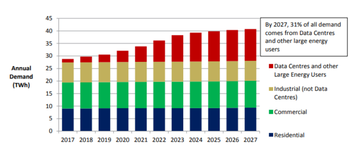Last week’s Sunday Times of Ireland put the cat among the pigeons. Economics columnist Edward Lucey wrote an article, available in full on his blog, that argued that Ireland is stumbling into a crisis in which uncontrolled data center building could plunge the nation into power blackouts and jeopardize its climate targets.
“Irish consumers risk being caught in the middle as an irresistible force meets an immovable object,” said Lucey.
The irresistible force is the continued building of data centers, which are projected to use up to 30 percent of Ireland’s electricity before the end of this decade.
The immovable object is Ireland’s climate change commitment, which requires the nation to reduce greenhouse gas emissions by, seven percent per year in the 2020s - and that means shutting down fossil fuel electricity plants, shifting to wind energy.
The collision could produce “rolling blackouts” in Ireland, if data centers are not reined in, according to the Commission for Regulation of Utilities (CRU), and the Irish Industrial Development Agency (IDA) has warned that even amber alerts might deter foreign investment and harm the nation’s economy.
Data centers in a decarbonized grid
The article sparked a response from Schneider Electric’s Marc Garner - which didn’t mention Lucey by name, but addressed some of the same data points. Not surprisingly, Garner concluded that data centers are “vital”, and they could be part of the solution, helping the grid through measures such as onsite generation in microgrids, and offering their backup power to the grid.
How practical is all this? Let’s start from the basics.
Energy use round the world is still heavily dependent on fossil fuels, both through the electric grid and alongside it. Energy use is intensely variable by social and climate factors but, in developed nations, a large amount of our energy comes via the electric grid which has a mix of fossil and renewable sources, while other sectors burn fossil fuel directly.
In the UK, for instance, we’ve nearly got rid of coal from the grid, but 40 percent of our electricity comes from fossil natural gas. Heating and transport are generated almost entirely from fossil fuels: we heat our homes with gas, and power our cars and trucks with oil.
The country has promised to decarbonize by 2050, and to reduce emissions by 78 percent before 2035. It’s a moot point whether these goals are enough, and also whether they can be achieved, because renewable energy supply is intermittent and it is a challenge to build enough capacity.
To add to that problem. heating and transport have to get off fossil fuels. That means electric boilers, and electric cars, which add up to increased demand on the grid. So electricity demand will go up, and renewable energy provision has to expand even faster to keep pace.
In that situation, we have to think carefully about any additional demands on the electric grid. Adding more demand will increase the amount of renewable energy required, and make the goal of net-zero harder.
Of course, data centers are high-margin businesses, and are able to pay green tariffs, but it was quickly pointed out that this can be counterproductive - if one sector buys all the green electricity, there’s not enough for everyone else.
Countering that, hyperscale providers with big money are enabling the building of renewable energy. By buying up the entire output of proposed wind and solar farms through power purchase agreements, they enable that capacity to be built.
Data center operators will sometimes state that a development in one state or other is ”powered by” a renewable resource the operator has paid for. But, of course, the renewable resource is intermittent, while the data center demand is steady, so the operator has created a headache for the operator - providing energy to the data center when the solar farm isn’t producing.
The data center moratorium
Some cities have responded to this by issuing temporary moratoria on data center building - Singapore and Amsterdam for instance.
Ireland is the next hotspot for this argument, as it's a small but significant country, where data center building has become a significant consumer. Graphs from Eirgrid make it clear that without data centers, the electricity demand in the country would be flat. With the current rate of data center building, it’s going to grow very rapidly.
Among other options, the CRU’s consultation document suggests a nationwide moratorium on new data - which would be the largest such moratorium yet imposed. The idea has met with pushback from the industry, including a newly-formed advocate body, Cloud Infrastructure Ireland.
Other less palatable answers have been proposed, such as Fortress Energy’s suggestion of a liquefied natural gas (LNG) plant in Shannon to import fracked fossil gas from the US, and use some of the resulting energy to power a data center. That proposal keeps coming back despite its obvious contradiction of Irish energy policy.
Another CRU idea is for every facility to include the ability to support itself onsite with dispatchable generation capacity or storage equal to - or greater than - its demand. The word “dispatchable” is the rub there, as renewables aren’t dispatchable - able to be turned on at will.
And the storage option sounds tempting, as all data centers have energy storage equal to at least a couple of hours of their demand. The drawbacks there are that most of that storage is generally in the form of fossil diesel - and data center operators don’t want to share it. As Marc Garner probably knows, any other users of that storage will have to prise it from the operators’ dying hands.
What about a cap?
I wonder if there’s a way to make a moratorium work, and continue it. What if we said no new data centers were allowed, ever - unless an equivalent amount of capacity (measured by MW) was decommissioned?
What if we set an acceptable quota for data center power usage in a given country, and never exceeded it?
As researchers like Koomey and Shehabi have found, that is effectively how the US data center industry has kept its power demand limited. It turns out that new data centers are more efficient than old ones, and efficient cloud data centers with the economies of scale, have replaced a lot of less efficient enterprise capacity.- so in the US data center power demands rose just six percent in the time it took for compute to jump 550 percent.
The idea of a quota for energy use in a sector will be anathema to those who idolize free markets. But we have a problem in that the environmental impact of our energy use is vastly greater than its financial cost, and we can't maintain unlimited growth - not while we have no effective way to remove existing CO2 from the air.
For instance - the commercial Orca carbon-capture system in Iceland can remove carbon from the air, and could offset our flights. But, until it becomes more well developed, each tonne of carbon captured by Orca costs $1200, many times the cost of the energy that we burnt to release it.
If there were a cap on the total data center energy demand, it would establish new ways to value data center capacity. Facilities that generate no actual benefit, like Bitcoin mines, would have to justify their existence, competing for quota with facilities that have direct applications.
Those operating older, less efficient data centers could find they have more incentive to shut them. Providers who want to open new higher-capacity facilities would actually pay to help decommission the old facilities and free up the rationed capacity.
There would obviously be hurdles to overcome in this.
One problem would be the initial data. There is no detailed data center census, and lists are likely to be inaccurate. As the US government found in its consolidation initiative, it's hard to know what capacity is there, and as you close down old facilities, others keep coming out of the woodwork. This issue could be handled by giving old data centers some sort of time-limited value. Find them quickly and trade them in for modern capacity, or miss the boat!
On a global scale, each country's quota would be somewhat arbitrary. Some developing countries in Africa might actually not have enough MW of existing capacity to trade in for their future needs. Perhaps multinational operators could free up Wattage rations by upgrading their well-provided hubs, and trade them for capacity to develop new hubs. No new hubs could be developed without compensatory reductions elsewhere.
A cap on data center building could look like a fishing quota. They would address a similar issue. Unrestrained fishing depletes stocks and destroys ecosystems. The experience of smaller economies like Ireland makes it clear that unrestrained data center building is not compatible with hard decarbonization targets, no matter how green an individual data center may be.





